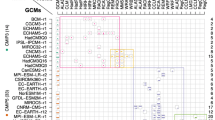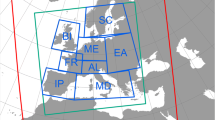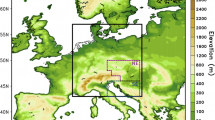Abstract
Uncertainties in future changes of temperature and precipitation over the homogenous monsoon regions of India are investigated using the CMIP5 and CESM-LE datasets. The uncertainty is partitioned into epistemic (model) and aleatoric (internal variability) components for each season using the RCP8.5 scenario. The uncertainty in temperature change is dominated by epistemic uncertainty that increases over time. The uncertainty in precipitation change shows a more complex picture. Aleatoric uncertainty can remain quite large and comparable to epistemic uncertainty till the latter part of the twenty-first Century especially during the JJA and SON seasons. Much of the rainfall uncertainty is in the more arid Northwest region with the West Central region (part of the core monsoon area) exhibiting lower uncertainties. Considerable increase in rainfall is seen during the SON season indicating an extended monsoon season. During the DJF season aleatoric uncertainty is much larger than epistemic uncertainty over much of the century and shows considerable decadal scale variability. Using the 40-member CESM-LE ensemble to analyze the influence of ensemble size on aleatoric uncertainty we find that low ensemble sizes can lead to an underestimate of the uncertainty.



















Similar content being viewed by others
References
Ashrit RG, Douville H, Kumar KR (2003) Response of Indian monsoon and ESNSO-monsoon teleconnection to enhanced greenhouse effect in CNRM coupled model. J Meteorol Soc Jpn81:779–803
Baker NC, Huang H-P, Jul (2012) A comparison of absolute and relative changes in precipitation in multimodel climate projection. Atmos Sci Lett 13(3):174–179
Chaturvedi RK, Joshi J, Jayaraman M, Bala G, Ravindranath NH (2012) Multimodel climate change projections for India under representative concentration pathways. Curr Sci Vol 103:No. 7
Christensen JH, Hewitson B, Busuioc A, Chen A, Gao X, Held I, Jones R, Kolli RK, Kwon W-T, Laprise R, Magaña Rueda V, Mearns L, Menéndez CG, Räisänen J, Rinke A, Sarr A, Whetton P (2007) Regional climate projections. In: Qin SD, Manning M, Chen Z, Marquis M, Averyt KB, Tignor M, Miller HL (eds.) Climate change 2007: the physical science basis. contribution of working group i to the fourth assessment report of the intergovernmental panel on climate change [Solomon]. Cambridge University Press, Cambridge
Christensen JH, Krishna Kumar K, Aldrian E, An S-I, Cavalcanti IFA, de Castro M, Dong W, Goswami P, Hall A, Kanyanga JK, Kitoh A, Kossin J, Lau N-C, Renwick J, Stephenson DB, Xie S-P, Zhou T (2013) Climate phenomena and their relevance for future regional climate change. In: Qin TF,D, Plattner G-K, Tignor M, Allen SK, Boschung J, Nauels A, Xia Y, Bex V, Midgley PM (eds.) Climate change 2013: the physical science basis. contribution of working group I to the fifth assessment report of the intergovernmental panel on climate change [Stocker]. Cambridge University Press, Cambridge
Collins M, Chandler RE, Cox PM, Huthnance JM, Rougier J, Stephenson DB (2012) Quantifying future climate change. Nat Clim Change 2(6):403–409
Collins M, Knutti R, Arblaster J, Dufresne J-L, Fichefet T, Friedlingstein P, Gao X, Gutowski WJ, Johns T, Krinner G, Shongwe M, Tebaldi C, Weaver AJ, Wehner M (2013) Long-term climate change: projections, commitments and irreversibility. In: Qin TF,D, Plattner G-K, Tignor M, Allen SK, Boschung J, Nauels A, Xia Y, Bex V, Midgley PM (eds.) Climate change 2013: the physical science basis. contribution of working group I to the fifth assessment report of the intergovernmental panel on climate change [Stocker]. Cambridge University Press, Cambridge
Douville H, Royer J-F, Polcher J, Cox P, Gedney N, Stephenson DB, Valdes PJ (2000) Impact of CO2 doubling on the Asian summer monsoon: robust versus model-dependent responses. J Meteorol Soc Jpn 78:421–439
Ekström M, Grose MR, Whetton PH, May (2015) An appraisal of downscaling methods used in climate change research. WIREs Clim Change 6(3):301–319
Hawkins E, Sutton R (2009) The potential to narrow uncertainty in regional climate predictions. Bull Am Meteor Soc 90:1095–1107. https://doi.org/10.1175/2009BAMS2607.1
Hawkins E, Sutton R (2011) The potential to narrow uncertainty in projections of regional precipitation change. Clim Dyn 37:407–418. https://doi.org/10.1007/s00382-010-0810-6
IPCC (2013) Summary for policymakers. In: Qin TF,D, Plattner G-K, Tignor M, Allen SK, Boschung J, Nauels A, Xia Y, Bex V, Midgley PM (eds.) Climate change 2013: the physical science basis. contribution of working group I to the fifth assessment report of the intergovernmental panel on climate change [Stocker]. Cambridge University Press, Cambridge
Jena P, Azad S, Rajeevan MN (2016) CMIP5 projected changes in the annual cycle of indian monsoon rainfall. Climate 4(1):14
Kay JE, Deser C, Phillips A, Mai A, Hannay C, Strand G, Arblaster JM, Bates SC, Danabasoglu G, Edwards J, Holland M, Kushner P, Lamarque JF, Lawrence D, Lindsay K, Middleton A, Munoz E, Neale R, Oleson K, Polvani L, Vertenstein M, Nov (2014) The community earth system model (CESM) large ensemble project: a community resource for studying climate change in the presence of internal climate variability. Bull Am Meteor Soc 96(8):1333–1349. URL https://doi.org/10.1175/bams-d-13-00255.1
Kirtman B, Power SB, Adedoyin JA, Boer GJ, Bojariu R, Camilloni I, Doblas-Reyes FJ, Fiore AM, Kimoto M, Meehl GA, Prather M, Sarr A, Schär C, Sutton R, van Oldenborgh GJ, Vecchi G, Wang HJ (2013) Near-term climate change: projections and predictability. In: Qin TF,D, Plattner G-K, Tignor M, Allen SK, Boschung J, Nauels A, Xia Y, Bex V, Midgley PM (eds.) Climate change 2013: the physical science basis. contribution of working group I to the fifth assessment report of the intergovernmental panel on climate change [Stocker]. Cambridge University Press, Cambridge
Knutti R, Jan (2010) The end of model democracy? Clim Change 102(3–4):395–404
Meehl GA, Arblaster JM, Tebaldi C (2005) Understanding future patterns of increased precipitation intensity in climate model simulations. Geophys Res Lett 32:L18719. https://doi.org/10.1029/2005GL023680
Meinshausen M, Smith SJ, Calvin K, Daniel JS, Kainuma MLT, Lamarque JF, Matsumoto K, Montzka SA, Raper SCB, Riahi K, Thomson A, Velders GJM, van Vuuren DPP (2011) The RCP greenhouse gas concentrations and their extensions from 1765 to 2300. Clim Change 109(1–2):213–241
Menon A, Levermann A, Schewe J, Lehmann J, Frieler K (2013) Consistent increase in Indian monsoon rainfall and its variability across CMIP5 models. Earth Syst Dyn 4:287–300. https://doi.org/10.5194/esd-4-287-2013
Parthasarathy B, Munot AA, Kothawale DR (1994) All-India monthly and seasonal rainfall series: 1871–1993. Theoret Appl Climatol 49(4):217–224. URL https://doi.org/10.1007/bf00867461
Rajeevan M, Bhate J, Kale JD, Lal B (2006) High resolution daily gridded rainfall data for the Indian region: analysis of break and active monsoon spell. Curr Sci 91:296–306
Roxy MK, Ritika K, Terray P, Murtugudde R, Ashok K, Goswami BN (2015) Drying of Indian subcontinent by rapid Indian ocean warming and a weakening land-sea thermal gradient. Nat Commun 6(1):7423
Sabeerali CT, Rao S, Dhakate AR, Salunke K, Goswami BN (2015) Why ensemble mean projection of south Asian monsoon rainfall by CMIP5 is not reliable? Clim Dyn. 45:161. https://doi.org/10.1007/s00382-014-2269-3
Saha A, Ghosh S, Sahana AS, Rao EP (2014) Failure of CMIP5 climate models in simulating post-1950 decreasing trend of Indian monsoon. Geophys Res Lett 41:7323–7330. https://doi.org/10.1002/2014GL061573
Sanap SD, Pandithurai G, Manoj MG (2015) On the response of Indian summer monsoon to aerosol forcing in CMIP5 model simulations. Clim Dyn. https://doi.org/10.1007/s00382-015-2516-2
Sanford T, Frumhoff PC, Luers A, Gulledge J (2014) The climate policy narrative for a dangerously warming world. Nat Clim Change 4(3):164–166. https://doi.org/10.1038/nclimate2148
Shashikanth K, Salvi K, Ghosh S, Rejendran K (2014) Do CMIP5 simulations of Indian summer monsoon rainfall differ from those of CMIP3? Atmos Sci Lett 15:79–85. https://doi.org/10.1002/asl2.466
Stocker TF, Qin D, Plattner G-K, Alexander LV, Allen SK, Bindoff NL, Bréon F-M, Church JA, Cubasch U, Emori S, Forster P, Friedlingstein P, Gillett N, Gregory JM, Hartmann DL, Jansen E, Kirtman B, Knutti R, Krishna Kumar K, Lemke P, Marotzke J, Masson-Delmotte V, Meehl GA, Mokhov II, Piao S, Ramaswamy V, Randall D, Rhein M, Rojas M, Sabine C, Shindell D, Talley LD, Vaughan DG, Xie S-P (2013) Technical summary. In: Qin TF,D, Plattner G-K, Tignor M, Allen SK, Boschung J, Nauels A, Xia Y, Bex V, Midgley PM (eds.) Climate change 2013: the physical science basis [Stocker]. Cambridge University Press, Cambridge
Taylor KE, Stouffer RJ, Meehl GA (2012) An overview of CMIP5 and the experiment design. Bull Am Meteor Soc 93:485–498. https://doi.org/10.1175/BAMS-D-11-00094.1
Terray L, Boe J (2013) Quantifying 21st-century France climate change and related uncertainties. CR Geosci 345:136–149
Trenberth K (1998) Atmospheric moisture residence times and cycling: implications for rainfall rates and climate change. Clim Change 39:667–694
Trenberth KE, Shea DJ (2005) Relationships between precipitation and surface temperature. Geophys Res Lett 32(14):L14703+. https://doi.org/10.1029/2005gl022760
van Vuuren D, Edmonds J, Kainuma M, Riahi K, Thomson A, Hibbard K, Hurtt G, Kram T, Krey V, Lamarque J-F, Masui T, Meinshausen M, Nakicenovic N, Smith S, Rose S (2011) The representative concentration pathways: an overview. Clim Change 109(1–2):5–31
Weigel AP, Knutti R, Liniger MA, Appenzeller C (2010) Risks of model weighting in multimodel climate projections. J Clim 23(15):4175–4191
Wilby RL, Wigley TML (1997) Downscaling general circulation model output: a review of methods and limitations. Prog Phys Geogr 21:530–548
Acknowledgements
We acknowledge the World Climate Research Programme’s Working Group on Coupled Modelling, which is responsible for CMIP, and we thank the climate modeling groups (listed in Table 1) for producing and making available their model output. For CMIP the U.S. Department of Energy’s Program for Climate Model Diagnosis and Intercomparison provides coordinating support and led development of software infrastructure in partnership with the Global Organization for Earth System Science Portals. We also acknowledge the CESM Large Ensemble Community Project and supercomputing resources provided by NSF/CISL/Yellowstone.
Author information
Authors and Affiliations
Corresponding author
Rights and permissions
About this article
Cite this article
Singh, R., AchutaRao, K. Quantifying uncertainty in twenty-first century climate change over India. Clim Dyn 52, 3905–3928 (2019). https://doi.org/10.1007/s00382-018-4361-6
Received:
Accepted:
Published:
Issue Date:
DOI: https://doi.org/10.1007/s00382-018-4361-6




